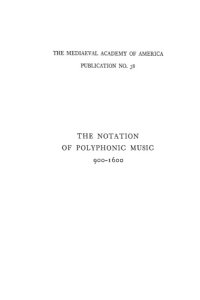
Ebook: The Notation of Polyphonic Music, 900-1600
Author: Willi Apel
- Genre: Art // Music: Guitar
- Year: 1961
- Publisher: Medieval Academy of Amer
- Edition: 5
- Language: English
- pdf
It is essential to remember that our present musical notation is actually the product of a long process and has changed over time to suit the needs of the composers and musicians in performing the kinds of music they were interested in making. If you know how to read our present notation you can pretty much handle anything from the late seventeenth century until today. Although there are other things you need to know the further you head back and if you find experimental 20th century notations, you are pretty much on your own without specialized knowledge of what the experimenter was trying to do.
This book was written to teach its readers about various aspects of musical notation prior to the seventeenth century. There are no bar lines, the note heads are connected in ways that look strange to us, and they are not round. What is all this about? This notation suited the kind of music they were making quite well. However, like all systems, it was kept around a bit too long after music changed. Once it became too cumbersome, the system we now use was born in order to provide greater rhythmic clarity and harmonic complexity.
This book was first published in 1941 by the great Willi Apel. The fourth edition was in print by 1949. This shows you how active the field was in those days. Many editions were made of the old music in our present notation so it could be more easily performed by modern day musicians. However, I must tell you that our notation with bar lines does present problems. For example, we expect that the first beat in a measure, the downbeat, to have a certain rhythmic weight, or in the case of jazz and especially rock, the second beat, the backbeat. This is not the case for this old music. They did not think or hear or sing that way. So, it becomes a re-learning for musicians trying to read modern notation, but sing the music appropriately. Apel does a great job of explaining things in an understandable way. He also provides loads of musical examples. Some are even in color (note the chapter on mannered notation)!
This edition, the fifth, was published in 1961 and by then had become an interesting technical subject for specialists. Reading about notational systems is not necessarily an exciting read, but I think it is quite interesting and provides insights for anyone interested in mediaeval and renaissance music.
This book was written to teach its readers about various aspects of musical notation prior to the seventeenth century. There are no bar lines, the note heads are connected in ways that look strange to us, and they are not round. What is all this about? This notation suited the kind of music they were making quite well. However, like all systems, it was kept around a bit too long after music changed. Once it became too cumbersome, the system we now use was born in order to provide greater rhythmic clarity and harmonic complexity.
This book was first published in 1941 by the great Willi Apel. The fourth edition was in print by 1949. This shows you how active the field was in those days. Many editions were made of the old music in our present notation so it could be more easily performed by modern day musicians. However, I must tell you that our notation with bar lines does present problems. For example, we expect that the first beat in a measure, the downbeat, to have a certain rhythmic weight, or in the case of jazz and especially rock, the second beat, the backbeat. This is not the case for this old music. They did not think or hear or sing that way. So, it becomes a re-learning for musicians trying to read modern notation, but sing the music appropriately. Apel does a great job of explaining things in an understandable way. He also provides loads of musical examples. Some are even in color (note the chapter on mannered notation)!
This edition, the fifth, was published in 1961 and by then had become an interesting technical subject for specialists. Reading about notational systems is not necessarily an exciting read, but I think it is quite interesting and provides insights for anyone interested in mediaeval and renaissance music.
Download the book The Notation of Polyphonic Music, 900-1600 for free or read online
Continue reading on any device:

Last viewed books
Related books
{related-news}
Comments (0)